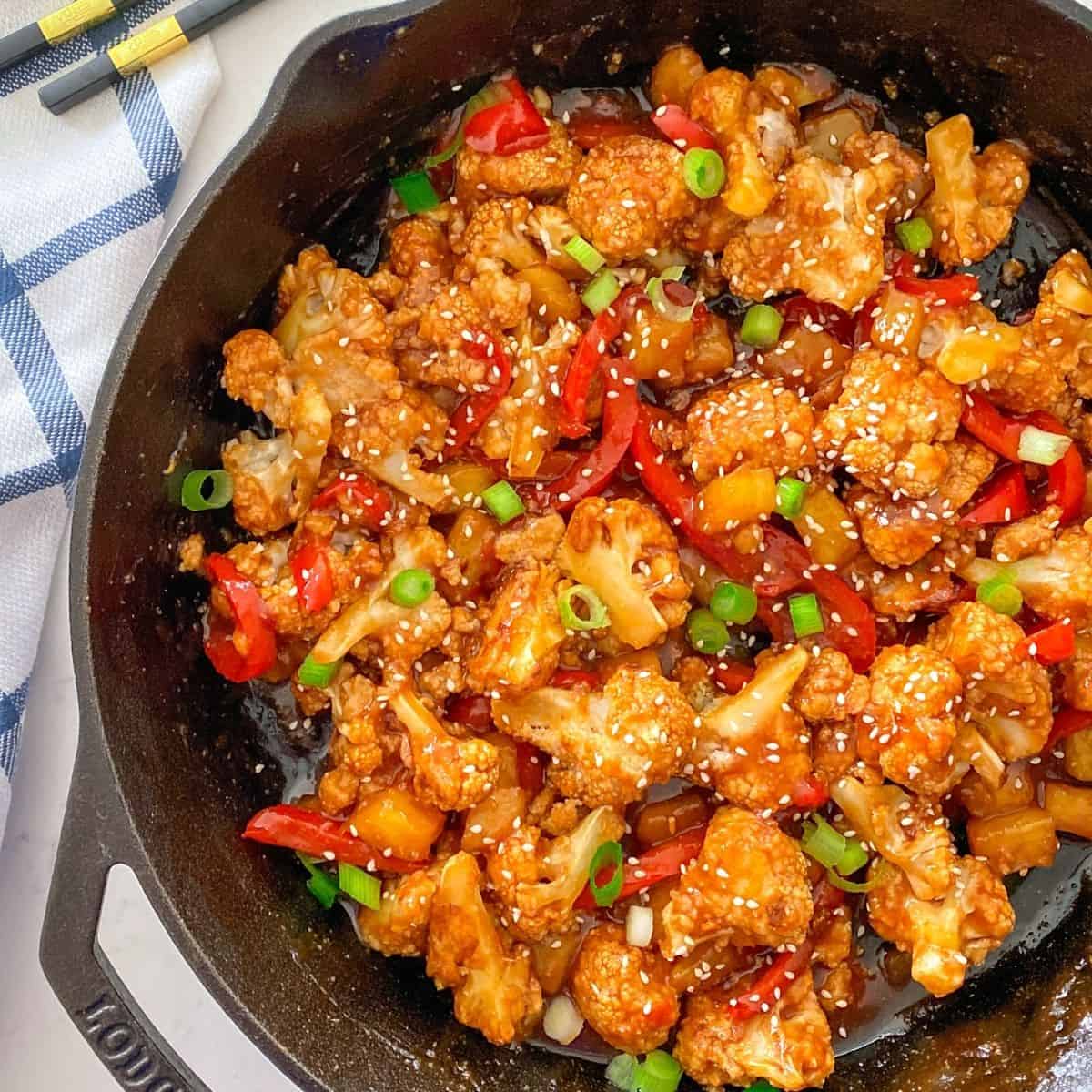Sweet and Sour Cauliflower: Vegetarian Delight
This vegetarian take on sweet and sour “chicken” features crispy cauliflower florets coated in glossy, balanced sauce with colorful vegetables. The magic lies in the textural contrast – shatteringly crisp cauliflower exterior gives way to tender interior, while the sauce perfectly balances sweet, sour, and savory notes. Pineapple adds natural sweetness and bright acidity that elevates the dish. The innovative preparation transforms humble cauliflower into crave-worthy centerpiece that delights vegetarians and meat-eaters alike.
Historical Context & Culinary Innovation
Sweet and sour sauce originated in China’s Hunan province, evolving through Cantonese immigrants to America with added pineapple. Cauliflower substitution emerged recently as plant-based eating gained popularity, offering meatless alternatives that satisfy cravings. Our recipe bridges traditions, respecting Chinese culinary roots while embracing modern dietary trends. The dish represents how global cuisines evolve – adapting to new ingredients and preferences while maintaining soul-satisfying essence.
Ingredient Selection Guide
Cauliflower: Choose tight, heavy heads with fresh green leaves. Cut uniform florets for even cooking. Soak in salt water to remove insects. For extra crispness, select smaller “baby” cauliflower.
Batter: Cornstarch creates crispiest coating. Add 1 tbsp rice flour for extra crunch. For gluten-free, ensure cornstarch isn’t contaminated. Potato starch works well too.
Sauce: Rice vinegar provides cleaner acidity than white vinegar. Use quality ketchup without high-fructose corn syrup. For depth, add 1 tsp mushroom powder.
Pineapple: Fresh pineapple offers brighter flavor. Reserve juice for sauce. Canned works but drain well. Grill pineapple first for caramelized notes.

Advanced Cooking Techniques
Frying: Fry at 350°F in batches. Double-fry for extra crispness – first at 325°F to cook through, then 375°F to crisp exterior. Drain on rack not paper towels to prevent steaming.
Sauce Thickening: Simmer until syrup consistency. Add cornstarch slurry (1 tbsp cornstarch + 2 tbsp water) if needed. The sauce should coat back of spoon thickly but drip slowly.
Vegetable Sauté: Cook vegetables until crisp-tender to maintain vibrant colors and nutrients. Blanch harder vegetables first. Add pineapple last to prevent mushiness.

Combining: Toss cauliflower with sauce just before serving to maintain crispness. For extra shine, add 1 tsp sesame oil to sauce. Serve immediately as crispness diminishes quickly.
Flavor Science & Chemistry
Acid in vinegar balances sugar through sensory contrast. Glutamates in tomatoes provide umami depth. Capsaicin in optional chili adds dimension. The frying process creates porous surface that absorbs sauce while maintaining crispness through starch gelatinization. Pineapple enzymes (bromelain) tenderize cauliflower slightly.
Nutritional Benefits & Health Aspects
High in vitamin C, fiber, antioxidants. Cauliflower contains sulforaphane with anti-cancer properties. Pineapple offers bromelain aiding digestion. For healthier version, air-fry cauliflower at 400°F for 15 minutes. Use honey instead of sugar. Increase vegetables like broccoli.

Creative Customizations
Vegan: Use flax egg substitute
Gluten-free: Verify soy sauce and use GF flour
Spicy: Add chili paste or fresh chilies
Protein: Add tofu, tempeh or chickpeas
Thai: Use tamarind paste and fish sauce
Professional Chef Techniques
1. Add orange zest to sauce for brightness
2. Garnish with crispy fried ginger for texture
3. Serve with coconut rice for Thai twist
4. Add cashews for crunch
5. Use black vinegar for deeper flavor
Serving & Presentation
Serve in colorful bowls with jasmine rice. Arrange cauliflower prominently. Garnish generously with sesame seeds, scallions, and cilantro. Provide chopsticks for authentic experience. For dramatic effect, serve in hollowed pineapple half. Pair with jasmine tea or lychee juice.
Storage & Reheating
Components store separately: refrigerate sauce 1 week, vegetables 3 days. Reheat cauliflower in air fryer to restore crispness. The sauce thickens when cold – thin with pineapple juice when reheating. Assembled dish doesn’t reheat well.
Cultural Significance & Modern Relevance
This dish represents culinary evolution – traditional Chinese-American flavors adapting to modern plant-based preferences. As vegetarianism grows globally, such innovations make ethnic cuisines accessible to all. The dish symbolizes how culinary traditions can evolve while respecting roots, creating inclusive eating experiences.
Final Thoughts
As you bite through crisp coating into tender cauliflower, appreciate how this innovative dish proves vegetables can be the star of satisfying, crave-worthy meals. May it inspire creative cooking and joyful eating in your kitchen for years to come.

Sweet and Sour Cauliflower
Ingredients
Method
- Dredge cauliflower in cornstarch, then egg
- Fry until golden, drain
- Whisk sauce ingredients
- Simmer until thickened
- Sauté peppers and onion
- Add pineapple and sauce
- Toss cauliflower with sauce
- Serve over rice
- Garnish with sesame seeds



